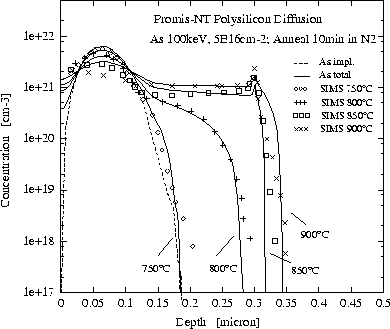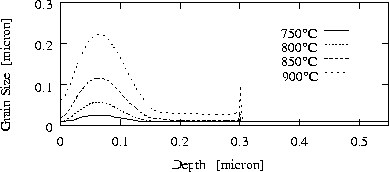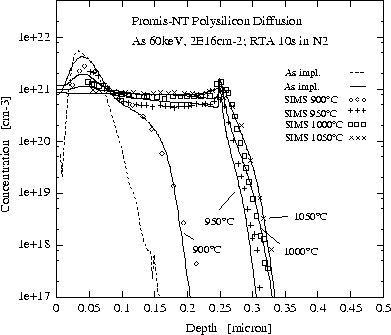Arsenic was implanted at 100keV energy with a dose of ![]() in
a
in
a ![]() thick polysilicon layer for the furnace annealing
experiments. Unfortunately, we do not know any details about the previous
deposition method, hence, we assume a deposition temperature of
thick polysilicon layer for the furnace annealing
experiments. Unfortunately, we do not know any details about the previous
deposition method, hence, we assume a deposition temperature of ![]() which results in amorphous polysilicon with an initial grain size of
approximately
which results in amorphous polysilicon with an initial grain size of
approximately ![]() . Figure 4.3-11 shows the results for
10min annealing at a temperature range from
. Figure 4.3-11 shows the results for
10min annealing at a temperature range from ![]() to
to ![]() .
.

Figure 4.3-11: Simulation results for polysilicon outdiffusion experiments. An
Arsenic doped ![]() polysilicon layer was annealed for 10min at
temperatures from
polysilicon layer was annealed for 10min at
temperatures from ![]() to
to ![]() .
.
As expected in the ![]() and the
and the ![]() case the dopant diffusion is
relatively slow, where in the
case the dopant diffusion is
relatively slow, where in the ![]() and
and ![]() case the poly-layer is
full with dopants. The concentration dependent grain growth behavior is
illustrated in Figure 4.3-12, where the vertical grain size for
different annealing temperatures is given. A strong dopant dependent grain
growth occurs in the high temperature cases. The vertical grain growth
is limited by the layer thickness, where the lateral extent of the grains
has no limitation.
case the poly-layer is
full with dopants. The concentration dependent grain growth behavior is
illustrated in Figure 4.3-12, where the vertical grain size for
different annealing temperatures is given. A strong dopant dependent grain
growth occurs in the high temperature cases. The vertical grain growth
is limited by the layer thickness, where the lateral extent of the grains
has no limitation.

Figure 4.3-12: Polysilicon grain size for temperature and dopant dependent grain
growth behavior for a temperature range of ![]() to
to ![]() . The
corresponding dopant profiles are shown in Figure
4.3-11.
. The
corresponding dopant profiles are shown in Figure
4.3-11.
The dopant exchange between grain interiors and grain boundaries is the dominating dopant transport mechanism. The trapping factor controls the amount of dopants which are captured by the grain boundaries and are therefore fast diffusers. The emission rate on the other hand determines the number of active and mobile dopants, which can be trapped by the grain boundaries.
For the RTA experiments a ![]() polysilicon layer was deposited at
polysilicon layer was deposited at
![]() on top of an
on top of an ![]() p-type silicon substrate. Then the
polysilicon was doped with arsenic at 60keV energy and
p-type silicon substrate. Then the
polysilicon was doped with arsenic at 60keV energy and ![]() dose, followed by a RTA anneal for 10sec. at
dose, followed by a RTA anneal for 10sec. at ![]() to
to ![]() . The
temperature profile of the anneal is given by a 12000K/min ramp-up from
. The
temperature profile of the anneal is given by a 12000K/min ramp-up from
![]() to the plateau temperature (
to the plateau temperature ( ![]() to
to ![]() ). Then the
temperature is kept constant for the 10s process time. At the end of the
cycle the temperature decays with a ramp-down rate of 2000K/min.
). Then the
temperature is kept constant for the 10s process time. At the end of the
cycle the temperature decays with a ramp-down rate of 2000K/min.
Figure 4.3-13 shows the outdiffusion profiles for the applied process conditions. There is a significant impact of the interfacial native oxide observed. For low temperature RTA experiments the native oxide layer is intact and the pile-up is fully established. At higher temperatures the native oxide breaks up and epitaxial realignment starts to affect the interface conditions. After the interface is totally aligned the dopant pile-up is drastically removed.

Figure 4.3-13: Simulation results for RTA outdiffusion experiments. Arsenic doped
polysilicon was annealed for 10sec. at temperatures from ![]() to
to
![]() .
.